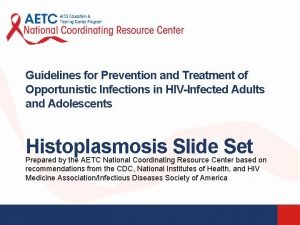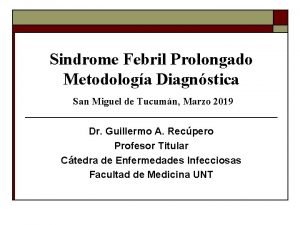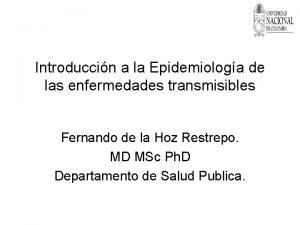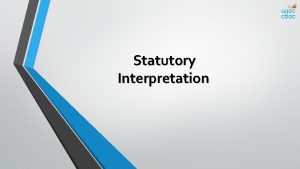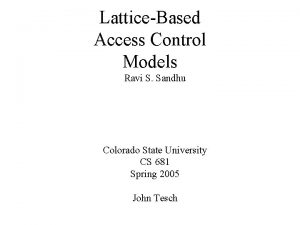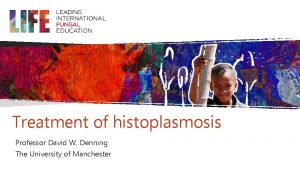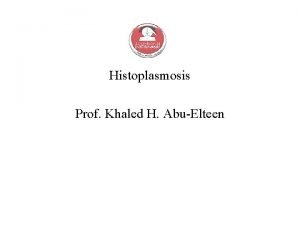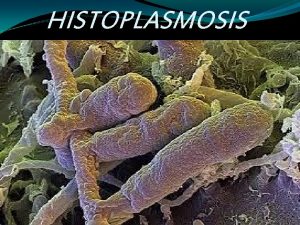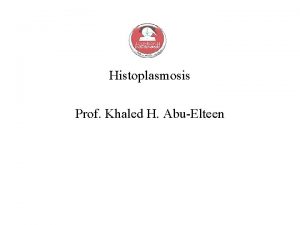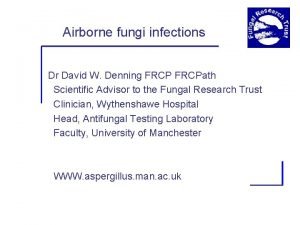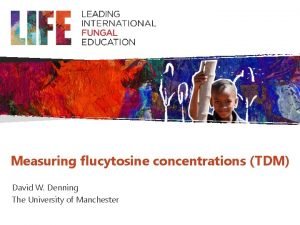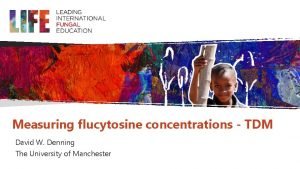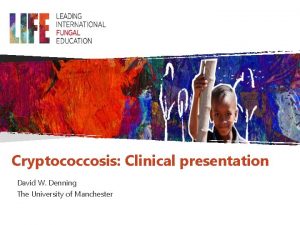Treatment of histoplasmosis Professor David W Denning The













- Slides: 13

Treatment of histoplasmosis Professor David W. Denning The University of Manchester

Intended Learning Outcomes To be aware of the treatment goals for histoplasmosis To be aware of manifestations that usually require treatment and those that do not To be aware of treatment outcomes in histoplasmosis

Overview • Antifungal treatment is always recommended for immunocompromised patients with histoplasmosis • Acute histoplasmosis resolves without treatment in most immunocompetent healthy individuals, in whom treatment is usually not recommended • BUT if immunocompetent patients are exposure to large inoculum of Histoplasma spp. and are highly symptomatic, antifungal treatment is advised • Early initiation of treatment is associated with shortened duration of illness and halts progression to persistent disseminated histoplasmosis and save lives in very ill patients

Which manifestations to treat USUALLY or ALWAYS treated Usually NOT treated • Acute pulmonary histoplasmosis (sometimes) • Acute pulmonary histoplasmosis (usually) • Chronic pulmonary histoplasmosis (always) • Pulmonary nodules • Progressive (Acute) disseminated histoplasmosis (always) • Chronic disseminated (adrenal, colonic, oropharyngeal etc) (always) Wheat et al. Infect Dis Clin N Am. 2016; 30: 207 -227 • Mediastinal histoplasmosis • Lymphadenopathy • Adenitis • Fibrosis • Presumed ocular histoplasmosis

Acute pulmonary histoplasmosis Don’t treat Treat • Moderate-severe disease • Diffuse bilateral infiltrates on chest imaging • Immunosuppression • Treatment options: • Amphotericin B for 1 -2 weeks followed by itraconazole for 12 weeks • Itraconazole alone for 12 weeks in mild to moderate disease • Asymptomatic patient • Mild disease • Focal infiltrates on chest imaging • Rationale: Wheat et al. Infect Dis Clin N Am. 2016; 30: 207 -227 • Mild acute pulmonary histoplasmosis is self-limiting

Progressive (acute) disseminated histoplasmosis Treatment goals • • Treatment should be continued for at least 12 months and until antigenaemia and antigenuria have resolved • Adjunctive interferon gamma is recommended in patients with IL-12 and IFN-ɣ deficiency • Plasmapheresis / rituximab for adult immunodeficiency syndrome Early and effective antifungal therapy Control of underlying immunodeficiency Hospitalised patients • • Liposomal amphotericin B for 2 weeks Then itraconazole for at least 1 year Check drug interactions Milder cases or in non-severely immunocompromised patients • Itraconazole for 12 months Note • Liposomal Am. B has a better response rate and lower mortality than conventional Am. B • Alternatives to itraconazole includes voriconazole, posaconazole and isavuconazole • Beware adrenal insufficiency Hage et al. Semin Respir Crit Care Med. 2015; 36: 729– 745. Vinh DC. Lancet Infect Dis. 2011; 11: 780 -92

Chronic disseminated histoplasmosis Benefits of antifungal treatment Treatment options • Resolution of gastrointestinal lesions • Itraconazole 200 -400 mg daily for 6 -12 months, unless already given empirical rifampicin for adrenal tuberculosis • Possibility of adrenal dysfunction recovery • Probably improved survival in those with adrenal masses and dysfunction • Avoidance of later complications (i. e. gut stricture or dissemination if immunocompromised) • Amphotericin B (preferably liposomal), if pretreated with rifampicin or other major drug interaction Precautions • Pro-actively address adrenal dysfunction to avoid cortisol deficiency and ‘Addisonian crisis’ • Ensure itraconazole levels are therapeutic

Chronic pulmonary histoplasmosis Benefits of antifungal treatment Treatment options • Induction of clinical and radiological remission • Itraconazole for 12 -24 months • Culture conversion Precautions • Improved survival • Ensure itraconazole levels are therapeutic • Chest imaging follow-ups: 4 - or 6 monthly • Relapse is common following treatment ~15% • Watch for primary lung cancer during or after treatment Wheat et al. Infect Dis Clin N Am. 2016; 30: 207 -227

Treatment for common histoplasmosis syndromes Adapted from Hage et al. Semin Respir Crit Care Med. 2015; 36: 729– 745.

Treatment outcomes • Response to therapy • 60 -80% • Factors responsible for worsening for symptoms includes • Treatment failure • Relapse occur in ~50% of responders • IRIS • Life-long therapy is recommended for patients with relapse • Mortality • 100% if untreated • CNS disease, ~80% (<5% with early diagnosis and early appropriate treatment) • HIV and disseminated, ~20 -40% • Other manifestations, 0 -10% • Non-histoplasmosis related events • Suspect IRIS if worsening of symptoms despite: - • Good adherence to antifungals • Therapeutic antifungal levels • Declining antigenaemia/antigenuria • Negative cultures for Histoplasma Wheat et al. Infect Dis Clin N Am. 2016; 30: 207 -227 Haynes et al. J Infect Dis. 2002; 185: 223 -8

Summary • Itraconazole is the first line of therapy for the treatment of histoplasmosis • Liposomal amphotericin B (preferable to deoxycholate ) is recommended for initial management of hospitalised patients and is associated with improved outcome • Be alert to and check for adrenal insufficiency, especially if rifampicin has been given • Treatment of disseminated disease should continue for at least 12 months and until antigenaemia and antigenuria have resolved • Alternative triazoles (voriconazole, posaconazole and isavuconazole) can be used for salvage therapy

References

Thanks for watching
 Mucormycosis ppt
Mucormycosis ppt Histoplasmosis treatment
Histoplasmosis treatment Histoplasmosis ganglionar
Histoplasmosis ganglionar Fiebre ondulante
Fiebre ondulante Microparasitos y macroparasitos
Microparasitos y macroparasitos Ocular histoplasmosis
Ocular histoplasmosis Promotion from assistant to associate professor
Promotion from assistant to associate professor Kathryn denning
Kathryn denning When does her wonderful adventure begin?
When does her wonderful adventure begin? Graham denning model
Graham denning model Objectives of interpretation
Objectives of interpretation Nikki denning
Nikki denning Phil denning
Phil denning Lattice based access control example
Lattice based access control example

